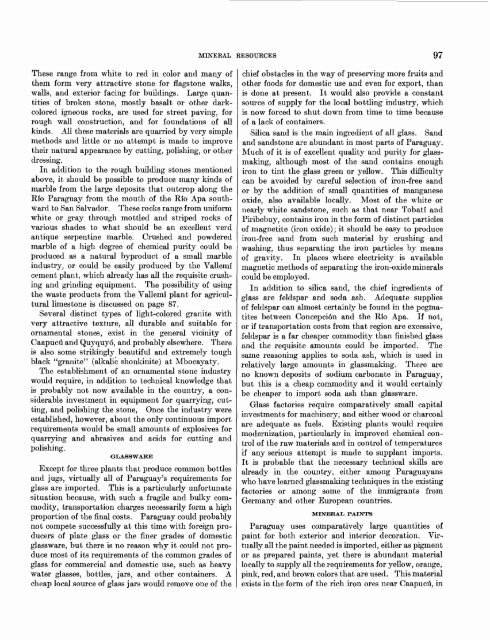Geology and Mineral Resources of Paraguay A Reconnaissance
Geology and Mineral Resources of Paraguay A Reconnaissance
Geology and Mineral Resources of Paraguay A Reconnaissance
- No tags were found...
You also want an ePaper? Increase the reach of your titles
YUMPU automatically turns print PDFs into web optimized ePapers that Google loves.
MINERAL RESOURCES 97These range from white to red in color <strong>and</strong> many <strong>of</strong>them form very attractive stone for flagstone walks,walls, <strong>and</strong> exterior facing for buildings. Large quantities<strong>of</strong> broken stone, mostly basalt or other darkcoloredigneous rocks, are used for street paving, forrough wall construction, <strong>and</strong> for foundations <strong>of</strong> allkinds. All these materials are quarried by very simplemethods <strong>and</strong> little or no attempt is made to improvetheir natural appearance by cutting, polishing, or otherdressing.In addition to the rough building stones mentionedabove, it should be possible to produce many kinds <strong>of</strong>marble from the large deposits that outcrop along theRio <strong>Paraguay</strong> from the mouth <strong>of</strong> the Rio Apa southwardto San Salvador. These rocks range from uniformwhite or gray through mottled <strong>and</strong> striped rocks <strong>of</strong>various shades to what should be an excellent verdantique serpentine marble. Crushed <strong>and</strong> powderedmarble <strong>of</strong> a high degree <strong>of</strong> chemical purity could beproduced as a natural byproduct <strong>of</strong> a small marbleindustry, or could be easily produced by the Vallemicement plant, which already has all the requisite crushing<strong>and</strong> grinding equipment. The possibility <strong>of</strong> usingthe waste products from the Vallemi plant for agriculturallimestone is discussed on page 87.Several distinct types <strong>of</strong> light-colored granite withvery attractive texture, all durable <strong>and</strong> suitable forornamental stones, exist in the general vicinity <strong>of</strong>Caapucii <strong>and</strong> Quyquyo, <strong>and</strong> probably elsewhere. Thereis also some strikingly beautiful <strong>and</strong> extremely toughblack "granite" (alkalic shonkinite) at Mbocayaty.The establishment <strong>of</strong> an ornamental stone industrywould require, in addition to technical knowledge thatis probably not now available in the country, a considerableinvestment in equipment for quarrying, cutting,<strong>and</strong> polishing the stone, Once the industry wereestablished, however, about the only continuous importrequirements would be small amounts <strong>of</strong> explosives forquarrying <strong>and</strong> abrasives <strong>and</strong> acids for cutting <strong>and</strong>polishing.GLASSWAREExcept for three plants that produce common bottles<strong>and</strong> jugs, virtually all <strong>of</strong> <strong>Paraguay</strong>'s requirements forglass are imported. This is a particularly unfortunatesituation because, with such a fragile <strong>and</strong> bulky commodity,transportation charges necessarily form a highproportion <strong>of</strong> the final costs. <strong>Paraguay</strong> could probablynot compete successfully at this time with foreign producers<strong>of</strong> plate glass or the finer grades <strong>of</strong> domesticglassware, but there is no reason why it could not producemost <strong>of</strong> its requirements <strong>of</strong> the common grades <strong>of</strong>glass for commercial <strong>and</strong> domestic use, such as heavywater glasses, bottles, jars, <strong>and</strong> other containers. Acheap local source <strong>of</strong> glass jars would remove one <strong>of</strong> thechief obstacles in the way <strong>of</strong> preserving more fruits <strong>and</strong>other foods for domestic use <strong>and</strong> even for export, thanis done at present. It would also provide a constantsource <strong>of</strong> supply for the local bottling industry, whichis now forced to shut down from time to time because<strong>of</strong> a lack <strong>of</strong> containers.Silica s<strong>and</strong> is the main ingredient <strong>of</strong> all glass. S<strong>and</strong><strong>and</strong> s<strong>and</strong>stone are abundant in most parts <strong>of</strong> <strong>Paraguay</strong>.Much <strong>of</strong> it is <strong>of</strong> excellent quality <strong>and</strong> purity for glassmaking,although most <strong>of</strong> the s<strong>and</strong> contains enoughiron to tint the glass green or yellow. This difficultycan be avoided by careful selection <strong>of</strong> iron-free s<strong>and</strong>or by the addition <strong>of</strong> small quantities <strong>of</strong> manganeseoxide, also available locally. Most <strong>of</strong> the white ornearly white s<strong>and</strong>stone, such as that near Tobati <strong>and</strong>Piribebuy, contains iron in the form <strong>of</strong> distinct particles<strong>of</strong> magnetite (iron oxide); it should be easy to produceiron-free s<strong>and</strong> from such material by crushing <strong>and</strong>washing, thus separating the iron particles by means<strong>of</strong> gravity. In places where electricity is availablemagnetic methods <strong>of</strong> separating the iron-oxide mineralscould be employed.In addition to silica s<strong>and</strong>, the chief ingredients <strong>of</strong>glass are feldspar <strong>and</strong> soda ash. Adequate supplies<strong>of</strong> feldspar can almost certainly be found in the pegmatitesbetween Concepci6n <strong>and</strong> the Rio Apa. If not,or if transportation costs from that region are excessive,feldspar is a far cheaper commodity than finished glass<strong>and</strong> the requisite amounts could be imported. Thesame reasoning applies to soda ash, which is used inrelatively large amounts in glassmaking. There areno known deposits <strong>of</strong> sodium carbonate in <strong>Paraguay</strong>,but this is a cheap commodity <strong>and</strong> it would certainlybe cheaper to import soda ash than glassware.Glass factories require comparatively small capitalinvestments for machinery, <strong>and</strong> either wood or charcoalare adequate as fuels. Existing plants would requiremodernization, particularly in improved chemical control<strong>of</strong> the raw materials <strong>and</strong> in control <strong>of</strong> temperaturesif any serious attempt is made to supplant imports.It is probable that the necessary technical skills arealready in the country, either among <strong>Paraguay</strong>answho have learned glassmaking techniques in the existingfactories or among some <strong>of</strong> the immigrants fromGermany <strong>and</strong> other European countries.MINERAL PAINTS<strong>Paraguay</strong> uses comparatively large quantities <strong>of</strong>paint for both exterior <strong>and</strong> interior decoration. Virtuallyall the paint needed is imported, either as pigmentor as prepared paints, yet there is abundant materiallocally to supply all the requirements for yellow, orange,pink, red, <strong>and</strong> brown colors that are used. This materialexists in the form <strong>of</strong> the rich iron ores near Caapucii, in
















